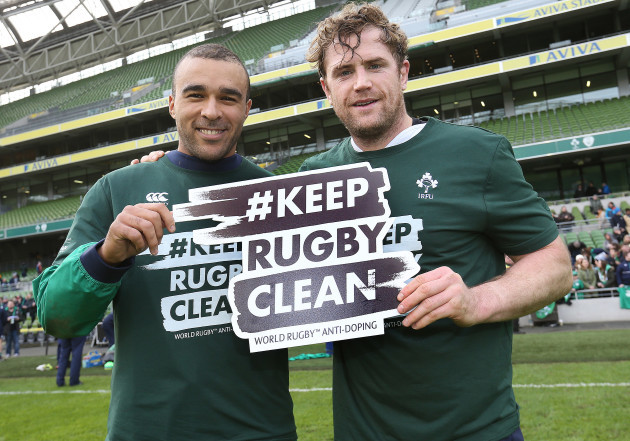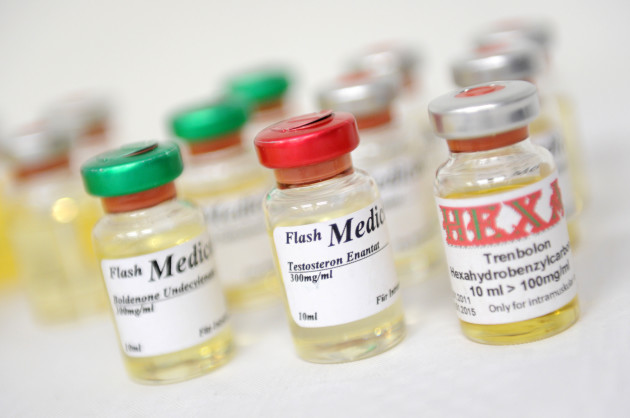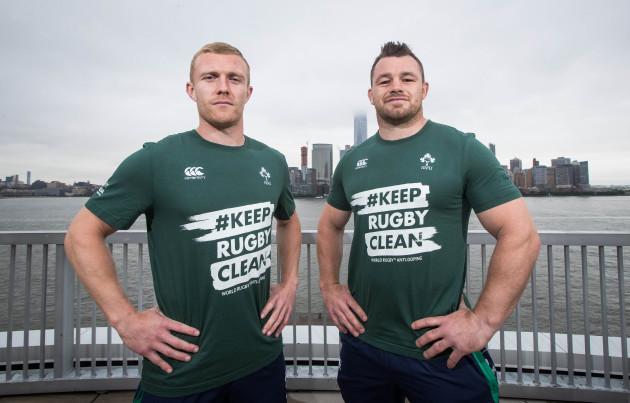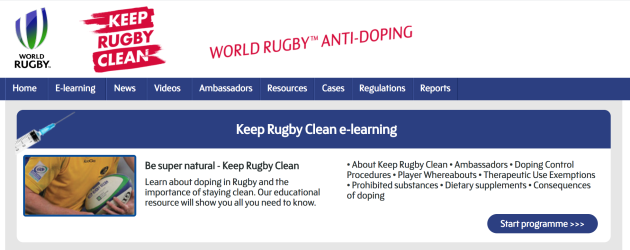DOPING IN RUGBY shot into the Irish public consciousness earlier this year when Munster’s Gerbrandt Grobler recovered from an ankle injury to come back into the selection picture for the province.
While the subsequent debate was unfair to the South African lock in many people’s eyes, the fact that the topic of drugs in rugby was back up for conversation was positive.
It’s something we talk about so rarely in this sport, mainly because professional players don’t test positive very often.
Grobler was handed a two-year ban in 2015 for use of the anabolic steroid Drostanolone and with very few other similar cases in Irish rugby, it wasn’t surprising that his previous suspension became a divisive talking point.
Just last week, we had another of those rare examples close to home, with Yorkshire Carnegie’s 20-year-old back row, Brandon Staples, a native of South Africa, suspended for four years after a test showed up three banned substances - Dehydrochloromethyl-Testosterone, Metandienone and Stanozolol.
Highlighting the fact that this doesn’t happen very often, the RFU said it was the first time a professional rugby player had tested positive under its remit since 2011.
However, just two days after Staples’ ban, Premiership club Wasps announced that one of their players, Ashley Johnson – also a South Africa native – has been provisionally suspended by the RFU after failing an anti-doping test earlier this year.
That case is still ongoing but Wasps said the RFU had found a “prohibited substance” when Johnson’s sample, taken in February of this year, was tested.
It might seem like a build-up of events, but really these are the slim pickings of professional rugby players being linked with doping.
Earlier this month, World Rugby released the results of its anti-doping programme for 2017 and it’s not very surprising that it slipped under the radar for many people, as tends to be the case unless there is news of a player being banned.
World Rugby’s anti-doping programme carried out 2,433 blood and urine controls in men’s and women’s rugby – sevens and 15s – last year, resulting in only three cases for anti-doping rule violations.
That’s just 0.1% of all controls leading to a case being opened against a player.
“We would treat it as a positive result because I think it confirms that there isn’t a serious doping issue at the top level of the game,” says Mike Earl, World Rugby’s anti-doping general manager.
“Now, that doesn’t mean we’re complacent but we feel that we do as much as we can such that if there was a problem out there, we’d be using all the tools available to us to find it.
“But I think in terms of the amount of testing that goes on at the top level of the game, we’re not finding a huge number of cases at that level. In that respect, it’s a good sign.”
While many critics are unconvinced that the rare cases of bans are reflective of the reality of how many players are doping or have doped, World Rugby stresses that it is doing its utmost to find them and always looking to evolve its anti-doping programme.
Many rugby-playing countries have their own national anti-doping organisations [NADOs] – the IRFU works closely with Sport Ireland in this country, for example – but World Rugby also runs its own global anti-doping programme, with players of 62 nationalities tested in 2017.
World Rugby works closely with the World Anti-Doping Agency [WADA] – whose lab in Utah is where World Rugby sends its samples for testing – and a wide range of NADOs around the globe to ensure it is operating with what is seen as best practice.
Out-of-competition testing has been a major focus in recent times, with 72% of World Rugby’s tests in 2017 carried out away from competitions, following 77% in 2016.
“If you are really serious about trying to find doping, then you test out of competition,” says Earl. “Because what you’ll find is that with things like steroids or EPO, people won’t take it around an event because you know you’re going to be tested.
“You dope in the period before the event and you would still get the benefit from the substance, but if you’re tested, it won’t show as a positive. If you really want to find doping, you test people at home, test them at training, test them at team hotels.”
The majority of World Rugby’s testing involves urine samples – they did around 400 blood tests last year – with Earl explaining that urine testing looks for “an entire spectrum of substances,” whereas blood testing is often focused on a specific substance like EPO or growth hormone.
World Rugby’s testing, both in- and out-of-competition, is generally extremely targeted, with specific players picked out for controls.
“Times have changed, certainly since I started in anti-doping,” says Earl, who joined World Rugby in 2016 having previously held similar roles with Uefa and the FA.
“Originally, it was a lot more random and you still had findings from random tests. But the whole anti-doping industry is now much more science-focused and it’s much more based on intelligent testing.
“There’s obviously a sliding scale; intelligent testing might just mean you’re looking at players who haven’t been tested for a while. At the top end, it could mean that you have specific data that would tell you a certain player was suspicious.
“If we ever had information that a player was potentially doping, then we would have a much better chance of detecting that in out-of-competition testing.”
That type of information can come from a whistleblower but is more often related to an Athlete Biological Passport [ABP], which essentially uses blood testing to track a range of biological variables over a period of time and can reveal the effects of doping.
Earl says World Rugby doesn’t “disclose how many athletes we put in it because it’s just not really a stat we’d share” when asked how many players are part of its ABP programme, but the 2017 results say the governing body collected 187 new samples.
“The players we put in that ABP pool would be players that either we thought were high risk or it might be that we take a selection of players playing in a particular position that we perhaps thought was more at risk for a certain type of doping,” explains Earl of the selection process.
“You’ll find across most sports that that pool is quite small, just for reasons of resources; you can’t physically put everybody in that. You try to have that as a high-risk pool.”
World Rugby’s data in recent years tells the governing body that anabolic steroids are the most common substances causing positive tests in rugby, but it is also concerned about growth hormone, growth hormone releasing factors, and erythropoiesis-stimulating agents, which can increase oxygen delivery to the user’s muscles.
To that effect, Earl is keen to stress that World Rugby sent 48% of its anti-doping tests last year for further analysis based on those substances.
“WADA mandates every anti-doping organisation to do a urine screen that covers a certain amount of substances,” says Earl. “We collect a sample, send it to the lab in Utah, the lab has to screen it for, hypothetically, 20 substances. That’s part of the standard screen.
“If we want to do more – for example, an EPO screen – we pay for additional testing on top of that. As a governing body, we choose to do that because we’re looking for doping.
“That’s us paying to look for extra things, so we feel that we use all the weapons that are available to us as an anti-doping organisation.”
World Rugby says it also stores some of its samples, allowing re-testing further down the line if new analysis comes to light or if it is discovered that there was a rise in the use of a certain substance in the past.
Again, Earl is not comfortable to reveal the scale of this part of World Rugby’s programme “for the deterrent reason.”
“If we reveal how many samples we stored, they’d know how much of a chance there was of being picked up again,” he explains.
The issue of Therapeutic Use Exemptions [TUEs] has been a major one in sports like cycling and athletics, but it was interesting to note that Sport Ireland’s figures for 2017 revealed that of the 27 TUEs it had approved, six were in rugby.
That figure is not related directly to World Rugby’s programme but Earl does say that if a player with a Sport Ireland-approved TUE comes to one of their competitions, World Rugby would recognise that TUE “because we know [Sport Ireland] is a WADA-recognised organisation.”
Earl estimates that, on average, World Rugby approves 10 TUEs per year, while he reckons there are “maybe 50 or 60 across the game” in total.
Right now, these numbers are not causing World Rugby concern.
“I wouldn’t necessarily say we’re concerned by it because we’ve not seen a pattern yet of anything that we consider to be a possible abuse, comparable with what we’ve seen in other sports.
“We’ve not seen anything yet that would suggest there has been an abuse of the TUE system.”
World Rugby’s anti-doping testing starts at U20 level but many in the game are increasingly worried about the possibility of schools players using banned substances, gaining the benefits even before they enter the elite levels of the sport.
Any testing in schools rugby would fall under the remit of NADOs – although in Ireland the IRFU doesn’t govern the schools competitions, so Sport Ireland cannot test at that level - but Earl says World Rugby is trying to help educate players from the earliest ages possible.
“The evidence would say there’s certainly a risk of it,” says Earl. “Players who compete in any sport, most of the scientific evidence will tell you that they will form their opinions at quite an early stage, probably early teens.
“So I think we do understand that and when they come into our competitions, the focus is on helping them to avoid accidental violations.
“We do a lot of education work on supplements, we do a lot of work on medications and we do the ethics stuff as well, but we do accept that we are getting them quite late in the game.
“We are trying to establish anti-doping educators in each country.
“Effectively, we want to have a player education pathway so that as they come into the game, they will start with a basic level of education and work right through. That’s the long-term goal but there’s an element of dissemination. It will be us setting it up and then the national unions at a national level will hopefully drive that through.”
Earl says that since last year World Rugby has been pushing funds into the area of anti-doping as part of its research grant programme, which more often sees injury-focused research funded.
The aim is to understand why players in different regions of the game turn to doping.
“What we’re trying to do long-term is look at that motivation – what’s motivating a positive case in South Africa compared to a positive case in the UK compared to France? Are they the same?
“Until we have that data, it’s difficult for us to come up with a definite profile because the motivations may be entirely different.”
Earl concludes by underlining World Rugby’s belief that helping players to understand that doping is not the answer is going to be key, as the governing body looks to keep the number of positive tests in professional rugby low.
“Education is the key,” says Earl. “If we can get to players and give them alternatives to doping, that’s the key. If you want to get bigger, we can give you an alternative to doping.
“In the long-term, we will hopefully have a well-educated group of players in the game who make the right decisions and if they’re worried, they know where to go to get the right kind of advice.”
The42 is on Instagram! Tap the button below on your phone to follow us!





